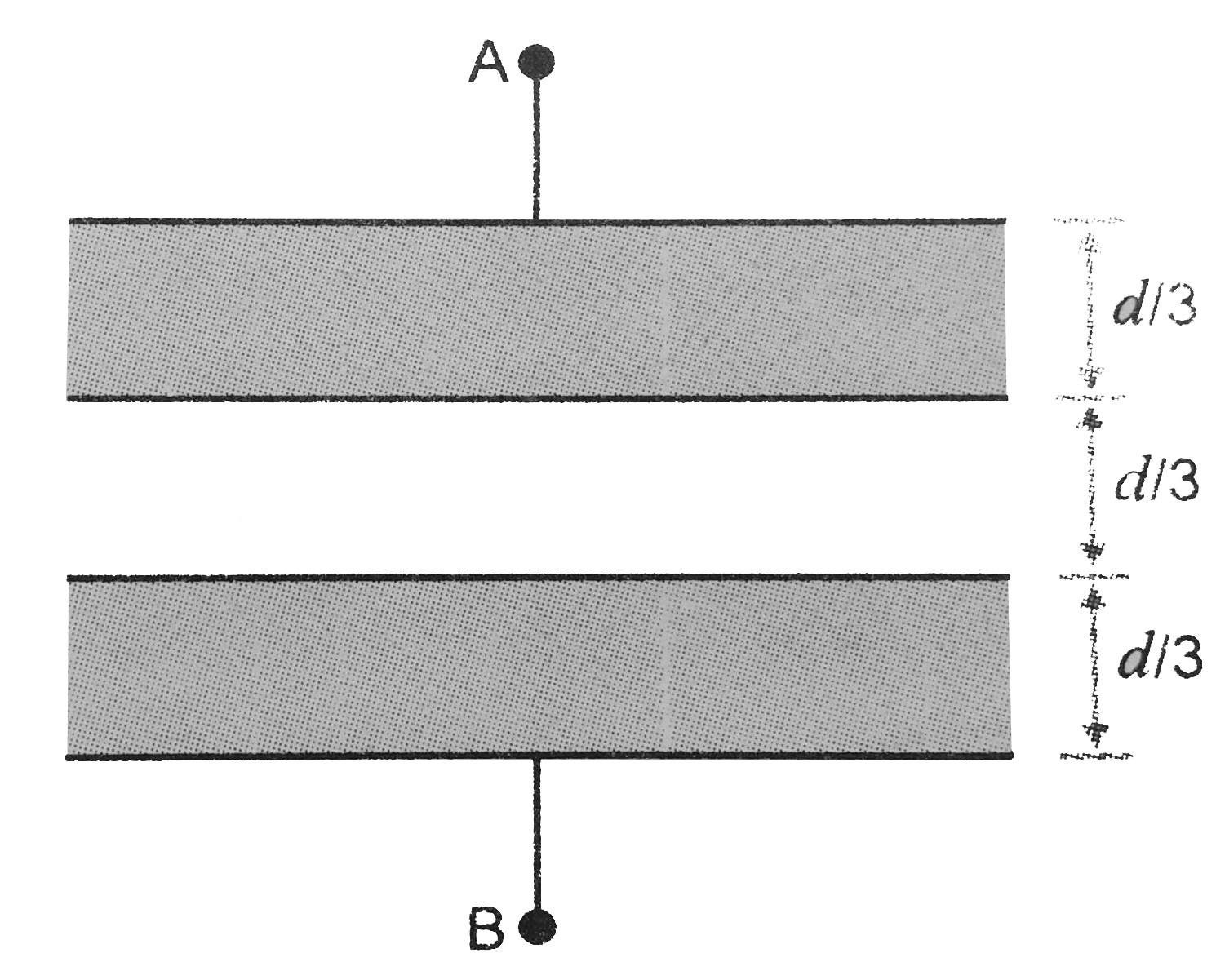Consider the situation shown in figure .The plates of the capacitor have plate area A and are clapmed in the laborstory . The dielectric slab is released from rest with a length a inside the capacitor. Neglecting any effect of friction or gravity, show that slab will execute periodie motion and find its time period.


Step by step video & image solution for Consider the situation shown in figure .The plates of the capacitor have plate area A and are clapmed in the laborstory . The dielectric slab is released from rest with a length a inside the capacitor. Neglecting any effect of friction or gravity, show that slab will execute periodie motion and find its time period. by Physics experts to help you in doubts & scoring excellent marks in Class 12 exams.
Updated on:21/07/2023Topper's Solved these Questions
- CAPACITORSBOOK - HC VERMACHAPTER - CAPACITORSEXERCISE - Exercise
2 Videos
- CAPACITORSBOOK - HC VERMACHAPTER - CAPACITORSEXERCISE - Objective 2
7 Videos
- BOHR'S MODEL AND PHYSICS OF THE ATOMBOOK - HC VERMACHAPTER - BOHR'S MODEL AND PHYSICS OF THE ATOMEXERCISE - Exercises
46 Videos
- DISPERSION AND SPECTRABOOK - HC VERMACHAPTER - DISPERSION AND SPECTRAEXERCISE - Exercises
11 Videos
Similar Questions
Consider the situation shown in figure. The plates of the capacitor have plate area 1A=lb1 and are clamped in the laboratory. The dielectric slab is released from rest with length a inside the capacitor. Neglecting any effect of friction or gravity, show that the slab will execute periodic motion and find its time period.

View SolutionThe plates of the parallel plate capacitor have plate area A and are clamped in the laboratory as shown in figure. The dielectric slab of mass m, length 2l and width 2l is released from rest with length l inside the capacitor. Neglecting any effect of friction or gravity, show that the slab will execute periodic motion and find its time period. (plates of capacitor are square plates of side 2l)

View Solution
Knowledge Check
A parallel plate capacitor has a dielectric slab of dielectric constant K between its plates that covers 1/3 of the area of its plates, as shown in the figure. The total capacitance of the capacitor is C while that of the portion with dielectric in between is C1. When the capacitor is charged, the plate area covered by the dielectric gets charge Q1 and the rest of the area gets charge Q2. The electric field in the dielectric is E1 and that in the other portion is E2. Choose the correct option/options, ignoring edge effects.
 A(a) E1E2=1B(b) E1E2=1KC(c) Q1Q2=3KD(d) CC1=2+KK
A(a) E1E2=1B(b) E1E2=1KC(c) Q1Q2=3KD(d) CC1=2+KKA parallel -plate capacitor, whose plates are kept horizotnal is charged from a cell and then isolated from it. A dielectric slab which can just fit in the gap between the plates is now inserted to fill exactly half of the gap and then left alone. Neglect gravity and friction. The slab will
Aremain stationaryBmove further into the gapCmove out of the gapDeither (b) and (c) depending on whether its dielectric constant is greater or less than 2
Concider the situation shown in figure .The width of each plate is b.The capacitor plates are rigidly clamped in the laboratory and connected to be a battery of emf ε All surfaces are frictionless .Calculate the value ofM for which the dielectric slab will stay in equilibrium.

View SolutionAn air-cored capacitor of plate area A and separation d has a capacity C . Two dielectric slabs are inserted between its plates in two different manners as shown . Calculate the capacitance in each case .

View SolutionFig shows a parallel plate capacitor of plate area A and plate separation d. Its entire space is filled with three different dielectric slabs of same thickness. Find the equivalent capacitance of the arrangment.

View SolutionFind the capacitances of the capacitance of the capacitors shown In figure .The plate area is A and the separation between the plate is d. Different dielectric slab in a particular part of the figure area of the same thickness and the entire gap between the plate is filled with the dielectric slabs.

View SolutionFigure shows two parallel plate capacitors with fixed plates and connected to two batteries. The separation between the plates is the same for the two capacitors. The plates are rectangular in shape with width b and length l1 and l2. The left half of the dielectric slab has a dielectric constant k1 and the right half k2 Neglecting any friction, find the ratio of the voltage of ihe left battery for that of the right battery for which the dielectric. slab mayremain in equilibrium.

View SolutionFigure shown pallel plate capacitors with fixed plate and connected to two batteries .The separation between the plate is the same for the two capacitors .The plates are rectangular in shape with width b and lengths l1andl2. The left half of the dielectric slab has adielectric constantK1 and the right half K2. neglecting any friction ,find the ratio of the emf of the right battery for which the dielctric slab may remain in equilibrium.
View Solution
